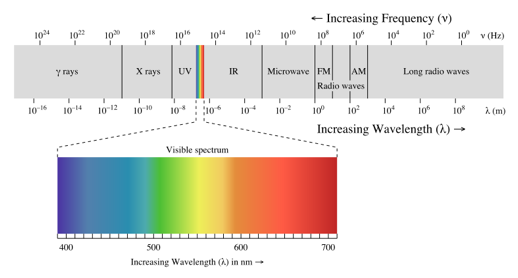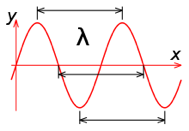The University of Vermont
Physics Department


The University of Vermont
Physics Department
The Nature of Light
Light that we perceive with our eyes lies roughly between 400 nm [275 S/D] and 700 nm [157 S/D] in wavelength. In the picture to the right, the wavelength, denoted by the Greek letter lambda, is defined as the distance between any two similar points on the wave. Below is a graphic of a familiar water wave showing the shortening of the wavelength, with a corresponding increase in frequency, as it approaches the shore. The frequency of a wave is defined as the inverse of the time between similar occurrences, such as the time between peaks. With an increase in frequency, the wavelength can be observed to shorten; likewise, a decrease in frequency would result in longer wavelengths.
The electromagnetic spectrum, depicted above, demonstrates the relationships between wavelength and frequency of light by delineating light into varying categories representative of particular wavelengths and corresponding frequencies. The light which the human eye perceives is a very small part of this spectrum referred to as visible light.
BACK
Visible Light



Drawing by Richard F. Lyon for Wikipedia
Drawing by Brews Ohare for Wikipedia.
Light is a wave that covers a wide range of frequencies, including cosmic radiation, microwaves, and radio waves. Light waves have both electric and magnetic components and are referred to as electromagnetic waves. Drawing by Philip Ronan for Wikipedia